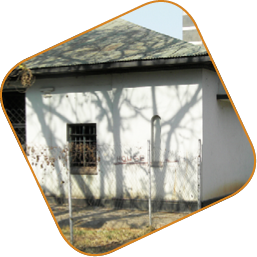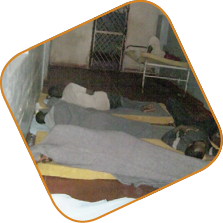7(B). Warehousing
As you can see it looks like a prison.
 Photo: Ndola closed male ward with small prison-like windows and no outdoor space. The psychiatric facilities contrast with the main hospital visible behind. 24 October 2012. © MDAC.
Photo: Ndola closed male ward with small prison-like windows and no outdoor space. The psychiatric facilities contrast with the main hospital visible behind. 24 October 2012. © MDAC.
There are 560 psychiatric beds in Zambia.120 Chainama Hills Hospital is the country’s only specialised psychiatric hospital. Psychiatric wards exist in seven general provincial hospitals spread around the country. In addition, the University Teaching Hospital in Lusaka provides outpatient mental health services.121
The seven psychiatric wards visited all had two wards of the same type (either open or closed) separated by the gender of the patients (their carers could be of any gender). Chainama Hills Hospital had locked acute wards and open wards for rehabilitation for men and women, and a dedicated “high cost” ward for fee-paying patients.122 The locked facilities at Ndola Unit and Chainama Hills Hospital were overcrowded.
When monitors visited the 22-bed male ward of Ndola Unit in October 2012, it had 45 patients including 14 “lodges” (people considered fit for discharge waiting for a relative to pick them up).123 The head of the unit described the situation as “chaotic” – the number has gone up to 60 people in the past. “As you can see, it looks like a prison,” he said.124 In January 2014 when monitors visited again, some walls had been painted but overcrowding was still apparent.
In Chainama Hills Hospital acute wards (male and female) nurses were at pains to acknowledge that the number of patients was more than the bed capacity as can be seen below in Table 1, showing occupancy in regional hospitals, and Table 2 showing occupancy at Chainama Hills Psychiatric Hospital.
 Photo: Side room in the Ndola closed male ward used for sleeping, as the main dormitory was so over crowded, 24 October 2012. © MDAC
Photo: Side room in the Ndola closed male ward used for sleeping, as the main dormitory was so over crowded, 24 October 2012. © MDAC
With the exception of the newly-renovated Livingstone unit, other psychiatric hospitals consisted of large dilapidated wards where nearly all patients slept in one room. Half the patients at Ndola Unit male ward and a quarter of patients at Chainama Hospital acute wards did not have their own bed: many slept on the floor, and many shared mattresses, some of which were filthy without sheets. In Ndola Unit the two toilets and one shared showering area lacked any respect for dignity: patients could not freely or privately use the showers, and the toilets lacked doors and were frequently in use. The overcrowding and prison-like windows of the Ndola Unit male ward meant that there was little fresh air.
In contrast, Livingstone had wards which opened in October 2013. They comprised smaller units with three to four people sharing each room with its own bathroom. Staff had requested the new facility long ago because of the dilapidated state of the old wards. The building was constructed in four months after the mental health staff threatened the hospital administration that they would stop admitting patients to the old ward and would instead admit patients to the general hospital wards.
The Ministry of Health reportedly plans to demolish Chainama Hills Hospital and build a new facility. Construction of new wards at Ndola should have started, but have been delayed.125
The tables below show the occupancy at the time of the visits in October 2012 for Chipata Hospital and at January and February 2014 for psychiatric units in Ndola, Kabwe, Livingstone and Chainama.
Table 1: Mental health provision in provincial hospitals 126
|
Hospital/Psychiatric Unit |
Ndola Unit – closed wards |
Kabwe Unit – open wards |
Chipata Unit – open wards |
Livingstone – mixture of open and closed |
||||
|
Ward |
F |
M |
F |
M |
F |
M |
Mixed |
Total bed capacity and number of patients on day of visit |
|
Bed capacity (number of beds on day of visit by monitors) |
15 |
22 |
7 |
9 |
20 |
28 |
18 (M=12 and F=6) |
119 |
|
Number of patients on the day of visit by monitors |
8 |
45 |
3 |
7 |
2 |
6 |
3 (1 M and 2 F) |
74 |
|
Reported average number of patients by officer in charge of ward |
15-20 |
45-60 |
3-5 |
10-13 |
12 |
18 |
40 (M=30 and F=10) |
N/A |
|
Age range of patients |
15-40 |
15-50 |
15-50 |
15-66 |
20-32 |
18-40 |
M=16-35 F=22-38 |
N/A |
|
Average length of stay |
1 |
1 month |
2 |
3 |
1 months |
1 |
M= 5 days F=8 days |
N/A |
|
Longest length of stay. |
2-3 months |
3 months |
3 |
30 years126 |
3 months |
3 months |
2 months (3 years for those abandoned by their family) |
N/A |
Table 2: Mental health provision in Chainama Hills Psychiatric Hospital 127 128 129 130 131 132 133
|
Ward |
A – high cost |
B – female acute |
C – male acute |
E – male open |
F – female open |
Forensic F127 (in B ward) |
Forensic M |
Total bed capacity and number of patients |
|
Bed capacity (number of beds on day of visit by monitors) |
7 |
50 |
36 |
25 |
15128 |
3 |
20 |
156 |
|
Number of patients on the day of visit by monitors |
3 ( 1F & 2M) |
35 |
50 |
8129 |
5130 |
2 |
17131 |
120 |
|
Reported average number of patients by officer in charge of ward |
10-15 |
55 to 60132 |
40-60 |
20 |
15 |
2 |
23 |
N/A |
|
Age range of patients |
23-50 |
20-45 |
13-70 |
35-60 |
Children to 45 |
37- 60 |
22 - 55 |
N/A |
|
Average length of stay |
2 |
1 |
1 |
5 |
1-3 |
Sentence dependent |
Sentence dependent |
N/A |
|
Longest length of stay |
5 years |
25 years |
20 years |
30 years |
10 years133 |
33 years (HEP) |
32 years (HEP) |
N/A |
120 Republic of Zambia, Mental Health Policy 2005, 5.
121 Others are: Choma General Hospital (Choma), St Francis Hospital (Katete District) and Senanga General Hospital (Senanga District).
122 ‘High cost’ patients at Chainama Hills Hospital were required to deposit 600 Kwacha (approximately 72 EUR), from which 40 Kwacha (approximately five EUR) was the daily rate for a room, 90 Kwacha (approximately 11 EUR) for nursing care, 50 Kwacha (approximately 6 EUR) for each review by a doctor, and 100 Kwacha (approximately 12 EUR) for a review by a consultant. The patient paid an additional fee when the deposit was exhausted. Among the other psychiatric units, only Ndola psychiatric female wards offered ‘high cost’ beds in smaller wards.
123 The staff informed monitors that they receive patients from the Central, Luapula, North Western and Copperbelt provinces.
124 Visit on 23 October 2012. As you can see it looks like a prison. Nurse in Charge, male ward, Ndola Psychiatric Unit.
125 Interview with Head of Clinical Care, Chainama Hills Hospital, 3 January 2014 and Head of Ndola Psychiatric Unit, Ndola, 27 January 2014.
126 One person with an intellectual disability was abandoned by relatives.
127 This was not a ward, but a small room inside Ward B which served as a female forensic ward. A prison officer was employed as a guard.
128 Seven beds were for children and eight beds for other patients (women to be discharged and patients with both mental health issues and medical conditions).
129 Out of the eight, two patients had absconded, and two were on leave visiting their families.
130 One child and four adults.
131 Six so-called HEPs (“At His Excellency’s Pleasure”) who were serving sentences and 11 people who were under observation to ascertain whether they were fit to stand trial; regulated by sections 160 to 167A (“Procedure in Case of the Insanity or Other Incapacity of an Accused Person”) of the Criminal Procedure Code Act, Chapter 88, Volume 7 of the Laws of Zambia.
132 In case of overcrowding, patients were transferred to ward F.
133 This is the length of stay of the only “child” on the ward, who was, at the time of the visit, in his mid-20s.

